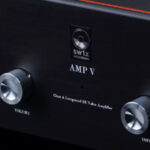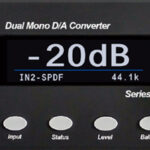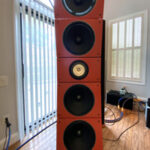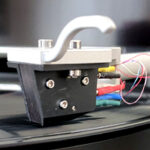- Home
- Equipment Reviews
-
Amplification Digital Integrated Mono Block Preamplifier Phono Solid State Tube Analog Sources Cartridges Tape Tone Arms Turn Tables Digital Sources Digital Disc Players DACs Music Servers Streaming Music Services
-
Accessories Power Conditioners Room Accoustics Racks & Stands Audio Software Other iPod iPod Speakers iPod Headphones iPod Transports Headphones Over Ear On Ear In Ear Headphone Amplifier
-
- Audio News
- Event Reports
- California Audio Show, San Francisco
- Consumer Electronics Show
- T.H.E. Show
- Rocky Mountain Audio Fest
- AXPONA
- Salon Son & Image
- Hi-Fi Show & AV Expo
- High End
- Lone Star Audio Fest
- Capital Audio Fest
- TAVES - Toronto Audio Video Entertainment Show
- AK Fest
- Home Entertainment Show
- New York Audio $ AV Show
- Open House Events
- Spotlight
- Music
- The Columns
- 2024 California Audio Show
Latest Reviews & Audio News
-

PS Audio AirLens and DirectStream DAC Mk2 Review
(July 26, 2024) -

Audio Note UK Meishu Tonmeister 300B integrated amplifier, P3 Tonmeister stereo amplifier, M6 Phono Balanced Preamp Review
(July 12, 2024) -

Douglas Schroeder’s One Year Exploration of Digital Front End Systems
(June 25, 2024) -

Arya Audio Labs RevOpods Anti-Vibration Feet Review
(June 25, 2024) -

Lego Icons Retro Radio Review
(June 14, 2024) -

SW1X Audio Design AMP V “Titan” Special directly-heated triode integrated amplifier Review
(June 14, 2024) -

Bricasti Design Model 1 Series II D/A Converter and M5 Network Player Review
(May 24, 2024) -

Star Wars – The Empire Strikes Back – In Concert, May 2, 2024
(May 20, 2024) -

PureAudioProject Quintet15 with Voxativ AC-X field-coil open-baffle loudspeaker system Review
(May 20, 2024) -

Technics SU-R1000 reference stereo integrated amplifier Review
(May 20, 2024) -

Computer Audio Design GC 1.1 & GC3.1 Ground Control external grounding systems Review
(May 20, 2024) -

Andy Grove of Audio Note UK on IO LTD
(March 23, 2024) -

Audio Note UK IO Limited field-coil cartridge system Review
(May 20, 2024) -

EMM Labs MTRX monoblock Input Board Upgrade Review
(March 7, 2024) -

May 2018 Sibelius Violin Concerto concert video via Berliner Philharmoniker Digital Concert Hall app
(February 16, 2024)
-
Categories
-
Amplification Digital Integrated Mono Block Preamplifier Phono Solid State Tube Analog Sources Cartridges Tape Tone Arms Turn Tables Digital Sources Digital Disc Players DACs Music Servers Streaming Music Services
-
Accessories Power Conditioners Room Accoustics Racks & Stands Audio Software Other iPod iPod Speakers iPod Headphones iPod Transports Headphones Over Ear On Ear In Ear Headphone Amplifier
Site Sections
Copyright ©1996-2024 All Rights Reserved.
Popups Powered By : XYZScripts.com

by: Andy Grove and Peter Qvortrup
FOREWORD
by Constantine Soo
In Dagogo’s preparation for the upcoming Audio Note DAC5 Special
Review, I have lobbied continuously for Peter to spare a few words on
the design of his top DAC. Co-authored by Andy Grove and Peter
Qvortrup of Audio Note, the resultant The DAC5 & A Small History is a
passionately written article, lined with delicious, rare insights into the
exhaustive efforts and ingenious thinking on one of modern day’s
most transcending implementations in home audio digital playback,
and it fulfilled my fancy more than I had hoped for.
Dagogo has the honor and pleasure of publishing Audio Note’s The
DAC5 & A Small History, and I would like to thank Peter Qvortrup for
his support.
The Audio Note DAC5 Special Review (2005) is in the works.
When the DAC5 was introduced in 1997, the perceived wisdom then was that the outputs of the raw DAC in the digital to analogue conversion process would generate high frequency noise in the form of a train of constant width, variable height rectangular pulses, thus destroying the fidelity of the converted signal.
The common solutions at the time were:
1) An extremely fast roll-off analogue filter after the DAC, the so-called brick wall filter. However, the fast roll-off in the analogue domain created serious phase problems at the high edge of the audio band, as well as ringing in the time domain.
2) A gentler analogue filter, and the use of digital filtering and oversampling. The most commonly used digital filter function is based upon the inverse
Fourier transform of a perfectly rectangular frequency response from –fs/2 to fs/2. This gives the familiar sin(x)/x time domain impulse response. It is
implemented in a Finite Impulse Response filter (FIR) and has linear phase (constant time delay with regards to frequency), with the added bonus of the weird, much discussed, pre- and post-ringing effect.
3) Use both. The oversampling process moves the “noise” up in frequency, where it can actually become more problematic. Very clever!?
“Nowadays many DACs and ADCs are of low basic resolution, relying on the use of signal processing and
complex algorithms to correct to the required paper specification…..”
A lot of ingenuity has, and continues to, go into solving the problem of out-of band noise or image frequencies. The availability and rapidly lowering cost of fast processing power has made signal processing the main area for development. Nowadays many DACs and ADCs are of low basic resolution, relying on the use of signal processing and complex algorithms to correct to the required paper specification.
There are some serious misunderstandings about oversampling and upsampling in the general market, and even amongst engineers, that somehow if you start with a 16 bit/44.1kHz signal, you can pass it through a magic box and it will come out at 24 bit and 192kHz. In fact, due to the finite resolution of the number crunching performed on the signal, the true resolution must necessarily be LOWER after processing rather than higher.
All that has actually happened is that the magic box has interpolated the signal.
To a large degree, the digitisation of anything is the conversion of a fine painting into a join-the-dots exercise. Oversampling and related filter algorithms attempt to join up the dots with smooth curves, which equates to the removal of out-of-band high frequency energy.
However, is the content of a CD to be regarded as pure “data”, where a theoretically perfect processing technique is to be regarded as the ideal? The
signal processing engineer will say “Yes, the data is processed to an accuracy of so and so bits, so mathematical errors are miniscule, the frequency response is flat within 0.001dB…” and so on. The pianist says “No, my Bosendorfer sounds like it’s made of plastic.”
“In fact, due to the finite resolution of the number crunching performed on the signal, the true reso- lution
must necessarily be LOWER after processing rather than higher.”
I don’t know where I picked it up, but there is the phrase, “Beauty is the great deceiver of man”. I would like to modify that slightly to make it more apt to this short essay:
“Order is the great deceiver of man”.
The original is still relevant, because Order is perceived as Beauty, especially by scientists, engineers and mathematicians. And, of course, Ancient Greek philosophers. It is true that nature has beauty in its patterns, but the perfect, ordered, Platonic Solids do not exist anywhere except in our minds, and perhaps in heaven. Even then we only know of a perfect right angle as a concept, it’s pretty hard to visualise one. The world of mathematics exists only in this Platonic world of perfection. Of course, the models it supports can be refined to produce astoundingly accurate predictions of reality. Which is quite handy to say the least. But, these extremely accurate predictions only work in extremely isolated circumstances. (What about the question “how big would a computer have to be to run a simulation of the universe”? Would it have to be bigger than the universe itself?)
So what has all this got to do with audio? Well, the signal processing engineer seeks to apply a mathematical algorithm and process the “data” on a CD. He seeks to use perfect, mathematically produced curves to join the dots. But hang on a minute; I can’t recall any great painters ever preferring 240V to a cheese sandwich…
In as early as 1993, the Audio Note brains creaked into action: Could it be that the use of DSP in removing out of band energy is responsible for the de-humanised nature of CD?
Is oversampling really not just a similar problem to applying feedback toamplifiers?
We did the experiment, and removed the digital filter from one of our previous generation DACs. The effect was not subtle. Although not perfect, that first prototype was rid of just about every trace of the plastic-synthetic sound which, certainly in our view, is the bane of CD.
The DAC5 project was born, and a new digital PCB was designed to treat the DAC IC like an analogue component. It was complimented by the best
components, and had low feedback, high current shunt regulators in its power supply.
The early DAC5s kept a low order analogue filter after the DAC. It was perhaps too early to let go of the “noise” problem completely. It was some time later, with the advent of an improved I/V transformer, that I decided to try eliminating deliberate filtering altogether. Instead, the I/V transformer operates with a damped load, which eliminates overshoot on the sampling frequency steps, to optimise the transient response of the system to them,
rather than the audio. That means that the bandwidth at that point is hundreds of kilohertz, so effectively no filter.
The output transformer on the DAC5 includes some small HF rolloff, it’s part of its nature, and the non-oversampled signal has a natural rolloff at high
frequencies as well, not the result of filtering.
The latest generation DAC5 includes a new output stage, and power supplies, both of which are technologies derived from the M10 preamplifier (Ed: MSRP $50k). The power supplies are impedance stabilised, and stand the output stage off from the mains supply; maybe the best metaphor is that they provide a calm sea for the output stage to sail in. The end result is a cleaner presentation, but without that held-back sterility which power supply regulators normally introduce.
It goes without saying that the componentry used in the DAC5 is of the utmost quality…
The heavily processed CD sound has become the sound of today. Most of the music buying public have no idea what an LP sounds like, and there is a good chance that a fair few of them wouldn’t like it. Digitally generated music probably sounds better on CD anyway. But if you prefer real, even organic food to plastic wrapped microwaveable ready meals, then maybe the DAC5 is for you…